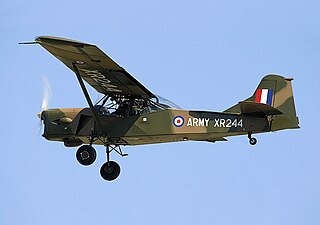
The Miles M.11 Whitney Straight was a 1930s twin-seat cabin monoplane designed and produced by the British aircraft manufacturer Miles Aircraft. It was named after Whitney Straight, a Grand Prix motor racing driver, aviator and businessman. The aircraft was the first to combine a side-by-side seating arrangement with an enclosed cockpit for the general aviation sector.

The PAC Cresco is a turboprop-powered derivative of the Fletcher FU-24 aerial topdressing aircraft, manufactured by the Pacific Aerospace Corporation in Hamilton, New Zealand. The Cresco was superseded by the PAC P-750 XSTOL in the early 21st century, but in 2019 was returned to production with the first new aircraft being completed 3 December 2020.

The Fletcher FU-24 is an agricultural aircraft made in New Zealand. Being one of the first aircraft designed for aerial topdressing, the Fletcher has also been used for other aerial applications as a utility aircraft, and for sky diving.

The Andrews A1 was a flying ½-scale replica of the un-built Andrews A2 New Zealand agricultural aircraft.

The PL-11 Airtruck is a New Zealand agricultural aircraft.

The Miles M.38 Messenger is a British four-seat liaison and private owner aircraft built by Miles Aircraft.

The Auster J/1 Autocrat was a 1940s British single-engined three-seat high-wing touring monoplane built by Auster Aircraft Limited at Rearsby, Leicestershire.

The Auster J/2 Arrow is a 1940s British single-engined two-seat high-wing touring monoplane built by Auster Aircraft Limited at Rearsby, Leicestershire, England.

The Auster J/4 was a 1940s British single-engined two-seat high-wing touring monoplane built by Auster Aircraft Limited at Rearsby, Leicestershire.

The Auster J/5 Autocar was a late 1940s British single-engined four-seat high-wing touring monoplane built by Auster Aircraft Limited at Rearsby, Leicestershire.

The Auster J/5 Aiglet Trainer was a 1950s British single-engined four-seat high-wing training and touring monoplane built by Auster Aircraft Limited at Rearsby, Leicestershire.

The Auster J/5 Alpine was a 1950s British single-engined four-seat high-wing training and touring monoplane built by Auster Aircraft Limited at Rearsby, Leicestershire.

The Auster J/1U Workmaster is a late 1950s British single-engined single-seat high-wing agricultural monoplane built by Auster Aircraft Limited at Rearsby, Leicestershire. Of traditional high-wing layout, it carries 90 gallons of spray fluid in a tank beside the pilot, an extra seat being provided for a passenger. The Lycoming 0-360-A engine of 180 h.p. driving a McCauley v.p. propeller giving it ample power; and slotted ailerons and balanced tail controls providing good handling. Oversize tyres were fitted. Take-off run at 2,550 lb gross weight and cruising speed at 65 per cent power are respectively 180 yd and 88 miles per hour (142 km/h). Britten-Norman spray gear was provided by Crop Culture, and this company ordered nine Workmasters.

The Auster AOP.6 was a British military air observation aircraft produced by Auster Aircraft Limited to replace the numerous wartime Taylorcraft Auster aircraft then in-service.

The Auster AOP.9 was a British military air observation aircraft produced by Auster Aircraft Limited to replace the Auster AOP.6.

The Auster D.4 was a two-seat British light aircraft, a development of the Auster Arrow with a horizontally opposed Lycoming engine, which originated from a Portuguese Air Force requirement for a liaison/training aircraft. Six were built by Auster Aircraft at their Rearsby, Leicestershire, factory, of which five went to Portugal, and nine more were built under licence in Portugal by the Oficinas Gerais de Material Aeronáutico OGMA from sets of components built by Auster and shipped from Rearsby. The original contract was for 25 sets of components but this was reduced in favour of the same number of additional Auster D5/160 sets.

The Beagle Husky was a three-seat British light aircraft built in the 1960s which originated from a Portuguese Air Force requirement for a liaison/training aircraft, a development of the Auster Alpha. It first flew as an Auster design in January 1960, but that company was taken over by Beagle Aircraft in September that year. It was initially available with a 160 hp Lycoming O-320 engine as the Auster D5/160.

The Yeoman Cropmaster was an Australian agricultural aircraft developed from the CAC Wackett trainer of World War II.

The Heston JC.6 was a British prototype air observation post aircraft designed and built by the Heston Aircraft Company Limited, who had previously built the Heston Phoenix, the Heston T.1/37 and the Napier-Heston Racer. The JC.6 was also known as the Heston A.2/45 or the Heston AOP.

The Short S.11 Valetta was a 1930s British passenger monoplane designed and built by Short Brothers at Rochester.




















